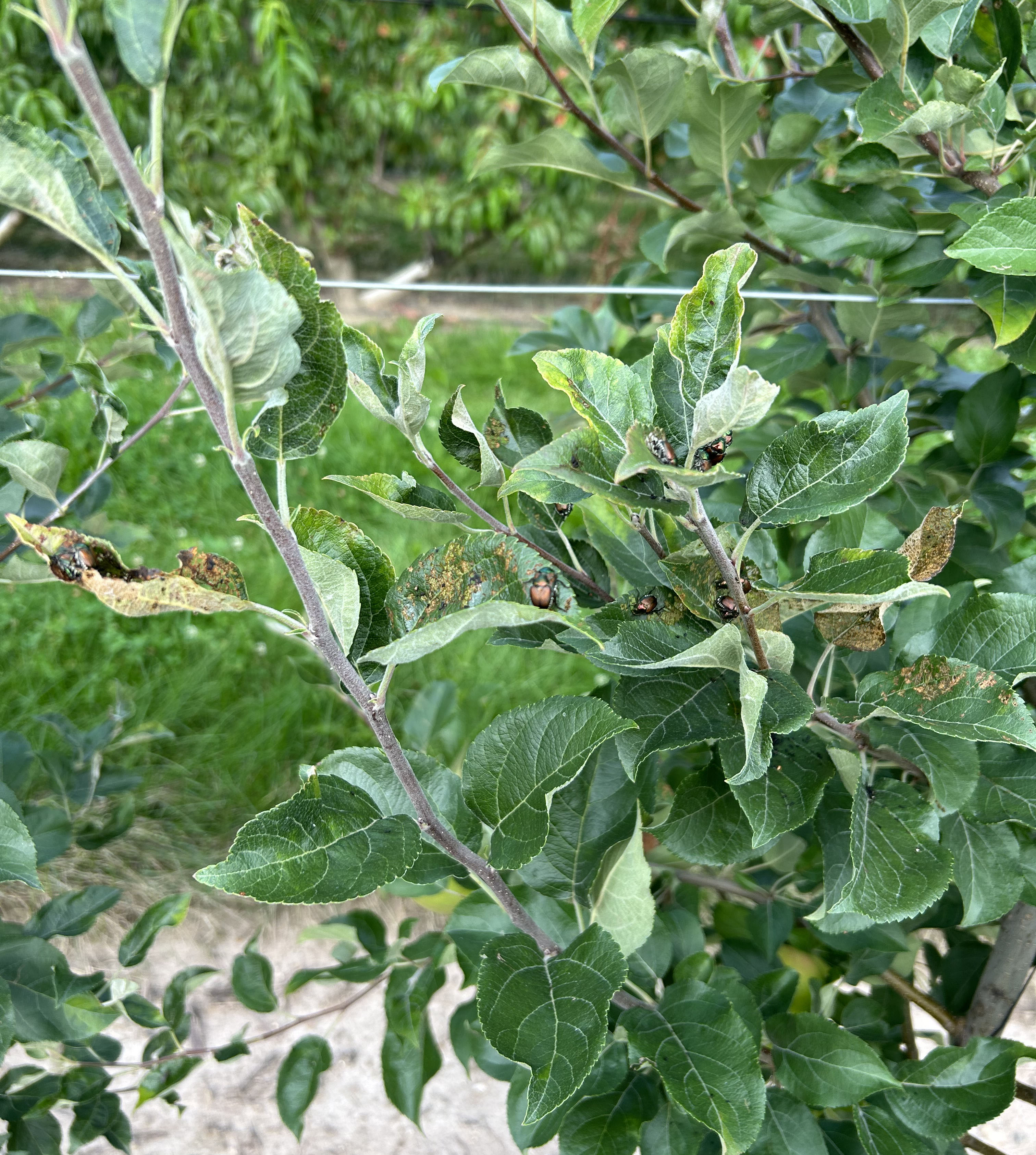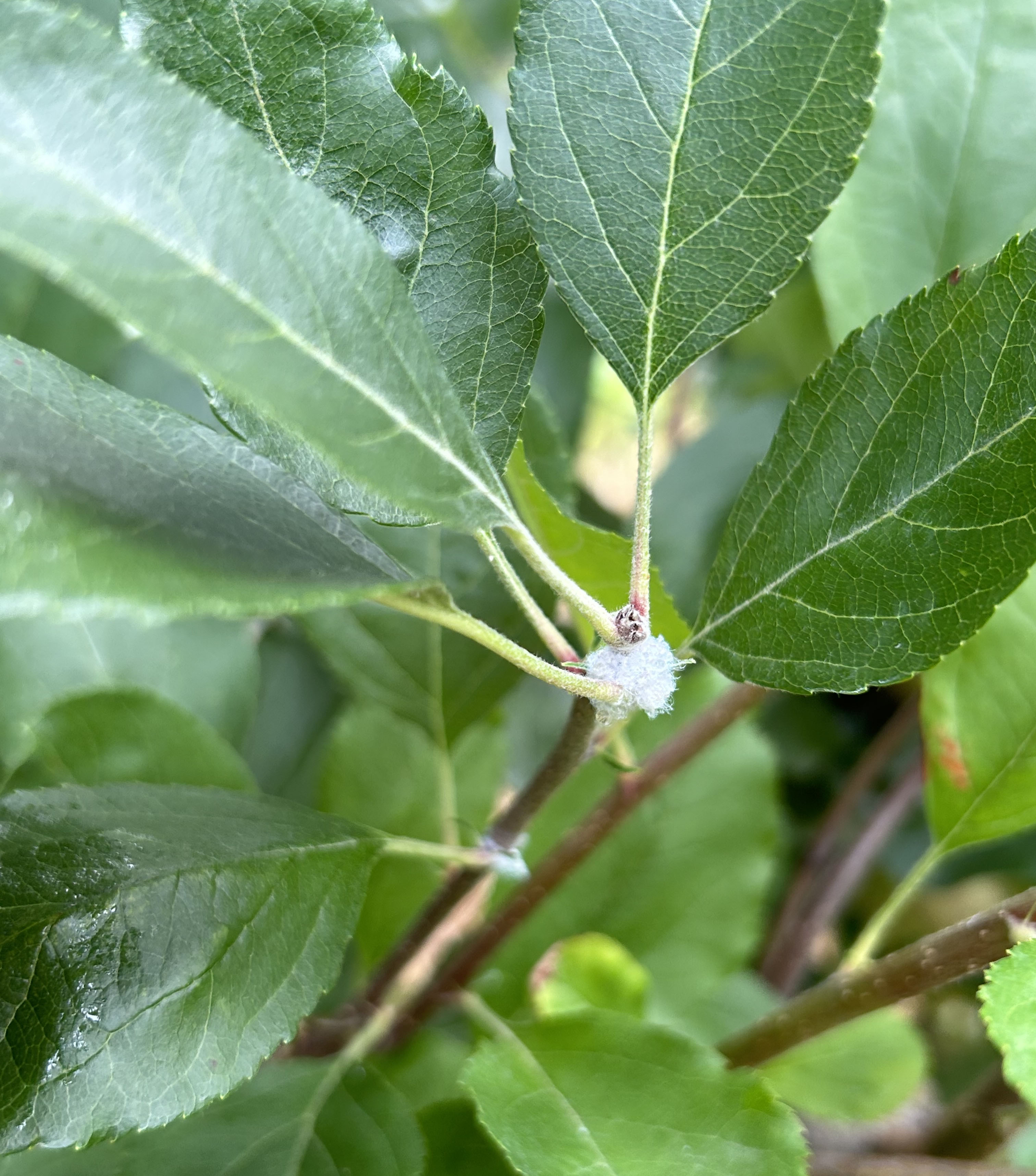Grand Rapids area tree fruit update – July 23, 2024
Early apple variety harvest is starting in the area.

Weather update and integrated pest management impacts
The Grand Rapids, Michigan, region is anticipating thunderstorms and showers Tuesday evening (July 23) into Wednesday morning. Following this weather system we are expecting fair, dry and cooler weather throughout the week. However, medium range and long range outlooks are calling for warmer than average temperatures headed into August with higher than normal precipitation as well.
Crop update
Peach harvest is underway in the area and early apple harvests are beginning for varieties like Pristine. I will start to look into other early varieties like Zestar and Paula Red starting next week.
With apple harvest closing in quickly, please keep a close eye on preharvest intervals.
|
Growing degree day (GDD) accumulation since Jan. 1 as of July 23, 2024 |
5-year average |
|||
|
Stations |
GDD42F |
GDD50F |
GDD42F |
GDD50F |
|
Aetna-Fremont |
2313 |
1440 |
2158 |
1386 |
|
Alpine |
2481 |
1579 |
2281 |
1480 |
|
Belding |
2435 |
1550 |
2238 |
1450 |
|
Conklin |
2499 |
1592 |
2306 |
1500 |
|
Grant |
2396 |
1520 |
2203 |
1423 |
|
Kent City |
2435 |
1542 |
2243 |
1456 |
|
Sparta |
2247 |
1549 |
2224 |
1434 |
|
Sparta-Tower |
2429 |
1531 |
2229 |
1436 |
|
Sparta-North |
2418 |
1521 |
2252 |
1455 |
|
Standale |
2570 |
1658 |
2340 |
1529 |
|
McIntosh growth stages |
GDD42F |
GDD50F |
|
Sixth cover |
2552 |
1663 |
|
Seventh cover |
2916 |
1917 |
|
Eighth cover |
3261 |
2153 |
We typically report GDD accumulation starting at March 1, but this is not a typical year. We reached the required chilling hours on Jan. 15 to move into ecodormancy and start accumulating GDD. This means the heat we received in February mattered for this year’s crop. As such, I will be reporting GDD from Jan. 1 rather than March 1 this season.
Disease update
Apple scab
While primary scab season is over, keep an eye out for secondary scab. This was a tough season to control with consistently windy conditions and unreliably predicted rain events. We are seeing small amounts of secondary scab throughout the region now. Please be sure to thoroughly scout prior to stopping scab controls.
Powdery mildew
At this point, the overwintering primary powdery mildew has ceased. However, this is a cyclic disease and if it has established a foothold it will continue to spread all summer long. While some powdery mildew won’t kill trees, it can rapidly get out of control and reduce photosynthesis throughout the canopy. Some sites have had strong powdery mildew pressure this season. Managing powdery mildew now will reduce overwintering inoculum in buds which can exacerbate winter injury.
Fruit rots
Start incorporating control measures for bitter rot and black rot now. Mummies and fallen fruit contain inoculum for this season. They are sporulating and infecting at this point in the season. Frog eye leaf spot from black rot is common in blocks across the area. The rain and heat this week will be very beneficial to the spread of these diseases.
Sooty blotch and fly speck
If you have sooty blotch and flyspeck developing, their symptoms should now be visible. The recent drier weather has limited infection and germination windows. However, please keep control for these fungal diseases in mind. The sooty blotch Enviroweather model can take your recent fungicide applications into account for making management decisions.
Cherry leaf spot
Cherry leaf spot is much more widespread than typical years, even in orchards with consistent programs. We are now seeing some early defoliation associated with cherry leaf spot, which can both harm this year’s crop and the overall tree health. Keep in mind that cherry leaf spot lesions look like small, reddish-purple dots (2-3 millimeters across). A key symptom is white, fluffy fungal growth on the underside of the lesions. These lesions can overtake leaves and lead to defoliation. We are especially seeing these symptoms in leaves that also have bacterial canker symptoms. While this disease is primarily thought of in tart cherry production, it can certainly impact sweet cherries too.
With cherry harvest now concluded, I am seeing orchard defoliation in the area more commonly. Keep in mind that stopping control at this point in the year will limit the amount of carbohydrates being stored by the tree and can increase the risk of winter injury. This can also impact next year’s fruit set.
Bacterial canker of stone fruits
Bacterial canker of cherry (caused by Pseudomonas sp.) and bacterial canker of peach and plum (caused by Xanthomonas sp.) is popping up across the state this season. Both diseases are associated with shot hole in the leaves, brown dry lesions on the fruit and cankers in the trees. This can also be associated with gummosis production, which is a general stress response by the trees. If you are seeing infections now, consider summer pruning to remove developing cankers, copper sprays at leaf drop and dormant copper next spring.
American brown rot
While cherry harvest is over now, peaches are also susceptible to American brown rot infection. As fruit gets closer to harvest, susceptibility to brown rot increases. Consider if brown rot management is needed. Using Indar may not be effective, even at the highest labeled rate of 12 ounces per acre. Previous research and resistance screening of American brown rot isolates in west central and northwest regions found that most screened fungal isolates had functional resistance to Indar in cherries. Find more information about this study. Effective materials for managing American brown rot include Merivon, Miravis and Cevya. Full coverage of all rows will be important to manage this disease.
Insect update
Codling moth
The second generation of adults are now flying and have not yet reached peak activity. Peak flight and egg deposition is likely to happen within the next week. Consider this article on codling moth management.
Obliquebanded leafroller

Obliquebanded leafroller populations have once again decreased, but leaf damage is visible.
Oriental fruit moth
The third generation of oriental fruit moth is emerging with peak adult emergence from July 23 – 28. Shoot tip damage associated with oriental fruit moth is visible throughout orchards now.

Other insects
Dogwood borer populations are decreasing in the area this week.
The first apple maggot was caught in southwest Michigan two weeks back. I would anticipate they are present in the area, but I have not yet found them on my traps.
Japanese beetle and rose chafer leaf damage is appearing in orchards this week. As they emerge, keep an eye out for leaf skeletonization.

The second generation of spotted tentiform leafminers is decreasing this week.
Potato leafhoppers are in lower populations this week. Keep an eye out for them in sticky traps and on the undersides of leaves. Look out for V-shaped, burnt leaf margins or cupping of young terminal leaves. Terminal leaf cupping underneath the leaves is common.
Woolly apple aphid colonies are still active and growing in orchards. Keep an eye on controlling colonies as we head into the harvest window. I have been seeing more green lacewings, which can control woolly apple aphid.

For more information about regional reports, please visit the Michigan State University Extension website.



 Print
Print Email
Email


